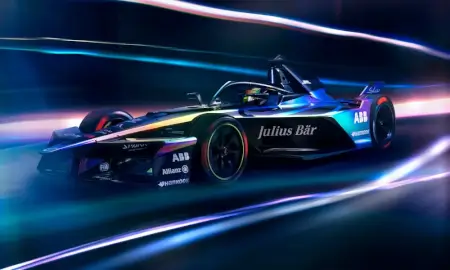April 26th 2024
Formula E reveals new-and-improved GEN3 Evo
Formula E has revealed its new GEN3 Evo race car, set to make its competition debut next season — a car that’s faster than the one it will replace, and tougher, too.
As the name suggests, the new car represents a progression from the GEN3, which is only in its second season of competition. Power (600 kW with regen), and the dimensions (5.016m x 1.7m) all remain the same as the outgoing car, as does the ability to have a 30-second, 600kW high-speed charge for Formula E’s anticipated introduction of fast-charging pit stops.
But thanks to a raft of upgrades throughout the car, there’s expected to be an overall performance gain of around two percent — equating to around 0.2s a lap. And that’s despite a modest weight gain of 19kg, taking it to 859kg overall including the driver.
“When I arrived in the business, one of the first things I saw was the development plan for the GEN3 Evo, and as a fan joining the business, not as the CEO, I looked at the step change in performance of that car and my question was, ‘Why isn’t this GEN4?’” Formula E CEO Jeff Dodds said of the new car’s performance gains in a media briefing ahead of the car’s unveiling in Monaco on Thursday. “It feels like the leaps in performance and technology are similar to what you saw from GEN1 to GEN2, and from GEN2 to GEN3.”
Among those improvements is all-wheel drive, which is being introduced for the first time.
While the outgoing car has a front powertrain to handle regen, the new car will have full AWD available for qualifying duels, race starts, and Attack Mode to improve acceleration — the dash to 60mph being completed in just 1.8s, which is 30 percent quicker than a Formula 1 car and around a 0.2 improvement on the current Formula E car — and grip, while adding another element of strategy in terms of when and where it is utilized.
There is also new bodywork which will not only aid the racing product thanks to improved aerodynamics, but it’s also more robust to cope with the rough and tumble of Formula E’s tight street circuits, too.
That aero is paired with better tires from Hankook, which are said to provide up to 10 percent more grip, according to the series. Hankook remains the spec tire supplier, fulfilling its final two seasons before Bridgestone takes over. Once again, the specification will be an all-weather tire with road relevance.
That aero is paired with better tires from Hankook, which are said to provide up to 10 percent more grip, according to the series. Hankook remains the spec tire supplier, fulfilling its final two seasons before Bridgestone takes over. Once again, the specification will be an all-weather tire with road relevance.
“We get asked lots of questions (like), ‘Why aren’t you on slick tires? Why aren’t you on high performing tires?’ and there’s a number of reasons for that,” Dodds said. “Partly sustainability, because we don’t want teams to be taking hundreds of sets of tires with them around the world for races. But it’s also partly because our manufacturers can take the tires that we work with in the race series, and variations of those tires can be used within their road cars. And we’ve just seen that, actually. We just saw Stellantis (represented in Formula E by DS and Maserati) launch the Abarth 600e, and they effectively launched it with a variation of the Formula E racing tire.”
The tires are also made from 35 percent recycled and sustainable materials (a nine percent jump from the current rubber), helping the car remain the world’s only net zero race car, with its production having a net zero carbon footprint and the car itself being made with recycled carbon fiber. The batteries are produced with minerals selected based on ethical and sustainable mining standards and will be recycled after use.
The car’s introduction comes at the same time as the expiration of the current homologation period for OEM-developed drivetrain elements. Once again, specific areas are open for development and will be subject to another two-year period of being locked in before the GEN4 car arrives in 2027.
But while this mid-cycle refresh is very much a new car in its own right — and teams have ordered new cars as well, they won’t be retrofitting GEN3s — it doesn’t mean Formula E has jumped the gun and inadvertently made the upcoming GEN4 less impressive by rolling out updates before that car’s 2027 debut.
“We probably could have squeezed a bit more technology and a bit more performance out of the GEN3 Evo if we’d have kept everybody working 24 hours a day,” Dodds said. “I think the sense is we didn’t need to do that because this is a material jump.
“But GEN4 and the specifications of GEN4 is a massive jump again, just through a battery size and capacity point of view, from a total power output point of view, from a styling and design point of view, (and) from a performance of the car point of view.”
For more information: www.racer.com
For more Industry News, please Click Here














